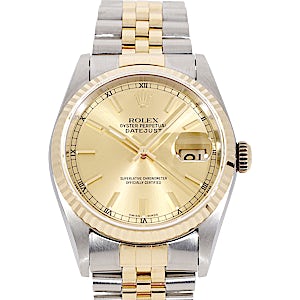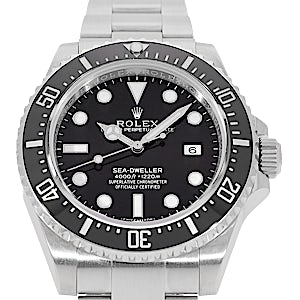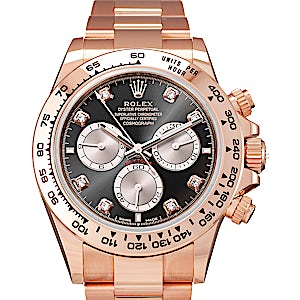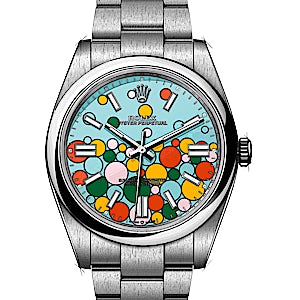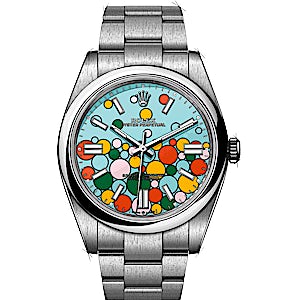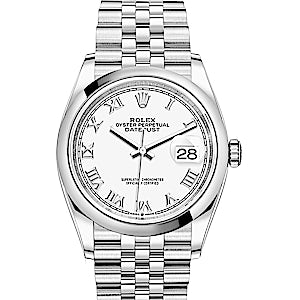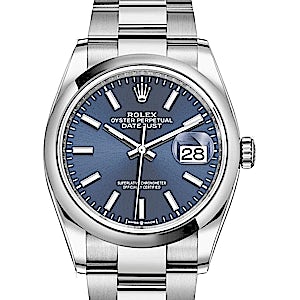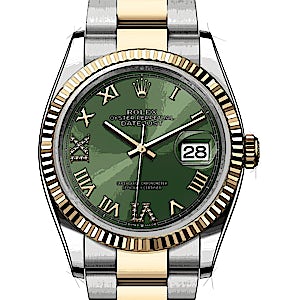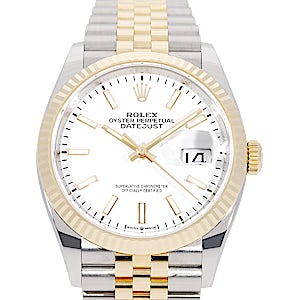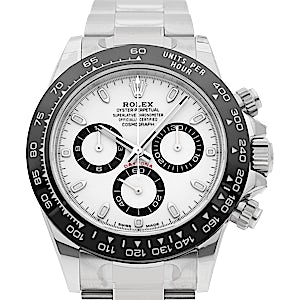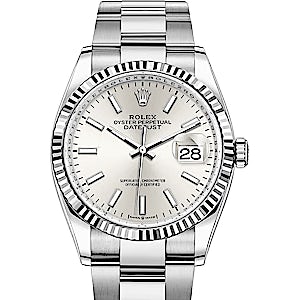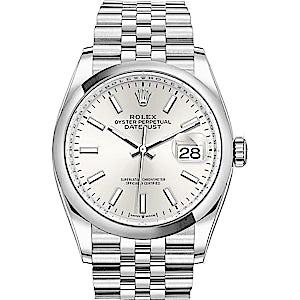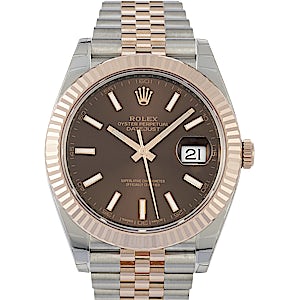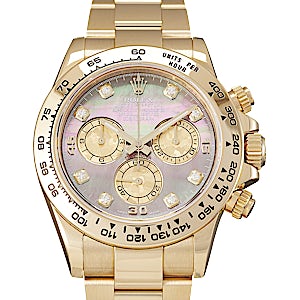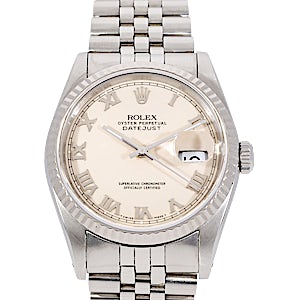Rolex Submariner, Sea-Dweller and Sea-Dweller Deepsea
Rolex describes the Submariner as the reference among diving watches and hits the nail on the head. No other diving watch enjoys such a cult status as the Submariner. The model has adorned the wrists of professional divers and enthusiasts alike since 1953. This is due to both the high functionality and the simple but striking design. While the Rolex Submariner Date offers a date function that is practical in everyday life, the Submariner is appreciated for its symmetry, and its resemblance to the first Submariner models in the 1950s - a version with a date was not added until 1966 with the Ref. 1680.
In addition to the Submariner, Rolex offers two other diving watches, the Sea-Dweller and the Sea-Dweller Deepsea, each with increased water resistance:
- Rolex Submariner: 300 metres diving depth
- Rolex Sea-Dweller: 1,220 metres diving depth
- Rolex Sea-Dweller Deepsea: 3,900 metres diving depth
One of the best examples of the professional use of the Submariner and Sea-Dweller is the cooperation between the Swiss manufacture and the French diving company COMEX (Compagnie Maritime d'Expertises). Since the 1960s, COMEX has been receiving Submariner and Sea-Dweller models characterised by COMEX lettering on the dial and corresponding engravings on the caseback. Rolex also benefits from the collaboration: for example, COMEX has developed a testing device that allows Rolex to simulate a diving depth of at least 3,900 metres to test the pressure resistance of the Rolex Sea-Dweller Deepsea. As a result, rare COMEX watches now command low to mid-six-figure prices, as the thought that the watch has been used in accordance with its intended purpose makes the hearts of many enthusiasts beat faster. You can also obtain certified Rolex Comex models online at CHRONEXT.
A vintage Submariner is available from CHRONEXT for 7,600 euros and a certified pre-owned model for 9,900 euros. Always including a 24-month CHRONEXT guarantee.
Rolex Cosmograph Daytona
If you compare the Rolex Daytona with the Patek Philippe Nautilus, both watches are characterised by at least three times their market value compared to their list price since 2021 - and the trend is upwards. For this reason, a Daytona is still an excellent investment. The high value combined with its robustness makes the Rolex Daytona an ideal investment that does not need to shy away from everyday use on the wrist and, due to its history, feels most at home in an automotive environment.
The Daytona has been in the range since 1963 and was named after the Daytona International Speedway, a world-famous race track in Florida. Rolex became the official sponsor for this race a year earlier. Because the earlier hand-wound models (four-digit references until around 1988) were slow sellers, these references are the most expensive today due to the low quantities, especially the Paul Newman Daytona (ref. 6239, 6241, 6262, 6263, 6264 or 6265), which is characterised by small squares on the totalisers of the dial.
Immediate availability: You can buy a vintage model from the Daytona collection online at CHRONEXT for 14,700 euros.
Rolex GMT-Master and GMT-Master II
The Rolex GMT-Master is the ultimate toolwatch for globetrotters. This is evident from the history of the GMT-Master, which was developed in collaboration with Pan American Airways to meet the needs of professional pilots. Since 1954, the Rolex GMT-Master - since 1989 the GMT-Master II - has been on the wrists of pilots, jet-setters and luxury lovers. With the help of the GMT bezel and the GMT hand, the GMT-Master II has what is known as a true GMT function, which allows a second time to be set independently of the first time zone.
The hype for the GMT-Master really took off with the launch of the new GMT-Master Pepsi in stainless steel (Ref. 126710BLRO). Since then, prices have been rising for all GMT-Master references - vintage or current. The Rolesor and full gold versions have also experienced a real boom since the introduction of the Everose gold models with the stylish lettering in powder pink (ref. 126711CHNR and 126715CHNR). Due to the high cost of current models, it can be worth buying vintage models such as the Ref. 1675 or Transitional references such as the Ref. 16750, especially for the Rolex GMT-Master.
You can buy well-preserved GMT-Master II watches at CHRONEXT for a price starting at 13,700 euros. A vintage model is currently even under 10,000 euros.
Rolex Sky-Dweller
In 2021, Rolex presented the Sky-Dweller, the youngest and most complicated model in the collection to date. The Sky-Dweller not only has a GMT function, which is realised by a number disc on the dial but also, for the first time in the history of the Swiss company, an annual calendar: while the day is shown in the date window, as usual, the respective month can be read off using a red rectangle behind the hour indices. In addition, the annual calendar offers the advantage that the date only has to be corrected once a year - in February.
Many watch aficionados appreciate the sophisticated complications of the Rolex Sky-Dweller, which can be useful in everyday life. The elegant attitude - the Sky-Dweller is one of the classic models and not part of the Professional series - in combination with the 42 mm diameter also make the watch a sought-after timepiece. Numerous variants of the watch are now available - in different materials and with different straps. While the Sky-Dweller in stainless steel is the most popular, the Rolesor model is similarly priced. This is an attractive opportunity for bi-colour lovers.
Rolex Milgauss
The Rolex Milgauss was presented in 1954 and was intended to serve as a reliable timepiece for researchers, engineers and other scientists working in areas with strong magnetic fields. The name Milgauss (French for "mille gauss" = 1000 gauss) indicates that the watch is resistant to magnetic fields of up to 1000 gauss thanks to its soft iron cage.
While the four-digit references of the Rolex Milgauss are sought-after vintage classics, the Milgauss with ref. 116400GV with its electrifying blue "Z-blue" dial, green sapphire crystal and orange lightning hand is enjoying ever-increasing popularity.
You can find used Milgauss watches at CHRONEXT for 7,900 euros. Always checked for authenticity by our certified CHRONEXT watchmakers and comes with a 24-month warranty.
Rolex Datejust, Datejust II and Datejust 41
Among all Rolex models, the Datejust is the oldest and the most versatile. The first Datejust was presented in 1945 on the occasion of the 40th anniversary of the company. This is also the reason for the naming of the famous Jubilée bracelet. The Datejust also bears its model name not by chance: it was the first watch with a date display that automatically changes at midnight. In around 80 model years, the Rolex Datejust was available in 26 mm and 28 mm (Lady-Datejust), 31 mm, 34 mm and 36 mm. Finally, in 2009, Rolex presented a 41 mm variant of the classic model for the first time with the Datejust II, which was replaced seven years later by the revised Rolex Datejust 41. While the Datejust II has sporty proportions, the Rolex Datejust 41 is more classic and has a newer calibre.
All Datejusts have an impressive variety of models in common: in addition to different diameters, there are different straps, bezels, dials and materials.
Optimal price-performance ratio: Buying a vintage Datejust offers you many advantages. In addition to immediate availability, you benefit, for example, from the stable value retention. At CHRONEXT, you can buy a vintage Datejust model for far less than 5,000 euros.
Rolex Day-Date, Day-Date II and Day-Date 40
The Rolex Day-Date is the most prestigious model of the Swiss luxury manufacturer and is revered as the ultimate symbol of power and success. Produced exclusively in gold and platinum, the timepiece has graced the wrists of numerous US presidents. For this reason, the Day-Date is also known as the "President's Watch" or the "Rolex President" - its three-row bracelet as the presidential band. Like the Datejust, the Day-Date offers numerous design options: In platinum or white gold, the Day-Dates offer a superb understatement, as only a trained eye will notice that this is not a stainless steel watch but the most prestigious model in the Rolex collection.
While vintage Day-Dates have an almost unattainable casual charm, modern Day-Date references are appreciated for their perfect workmanship. A special status is given to the Day-Date 40 in platinum, which is available with the famous ice-blue dial.
The price of a vintage Day-Date depends on many factors such as availability, demand and quality. At CHRONEXT, you can buy vintage models from the collection online for between 13,900 and 15,800 euros.
Rolex Explorer and Explorer II
To provide adventurers with a helpful, reliable timepiece, Rolex launched the Explorer in 1953 and the Explorer II in 1971. The Explorer I is a classic, robust three-hand watch that accompanied none other than Sir Edmund Hillary on the first ascent of Mount Everest. On the other hand, the Explorer II is aimed at spelunkers and expeditions inside the earth: Its 24-hour hand is designed to help the wearer keep track of time even in a dark environment.
Both models are increasingly becoming the focus of collectors and enthusiasts: the Rolex Explorer has an unmistakable charm in both 36 mm and 39 mm. A quick purchase can be worthwhile, as the costs for the Explorer are still comparatively manageable. The Explorer II, particularly with its white dial, is a successful and versatile change from the classic toolwatches, which usually have black dials. The vintage versions of both watches are particularly rare and ideal for a Rolex as an investment.
If you are looking for a comparatively inexpensive Rolex Explorer, you can get a vintage model at CHRONEXT from 6,800 euros.
Rolex Oyster Perpetual
If you're looking for a simple Rolex for every day, the Oyster Perpetual is a must-have. This understated Rolex model is available in a wide range of diameters and has all the characteristics for which Rolex is known and appreciated worldwide. These include the waterproof Oyster case, a reliable manufacture movement and the classic, unmistakable design language. Many dial variants can be found on the second-hand market in particular, but also references with diameters that are no longer produced, such as the Rolex Oyster Perpetual 39 (Ref. 114300).
You can get a Vintage Oyster Perpetual model for ladies at CHRONEXT for 2,600 euros; certified pre-owned models in our online shop will cost you between 2,900 and 8,400 euros.
